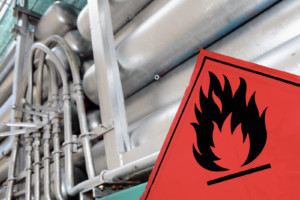3 Types of Hazardous Locations to Use Explosion-Proof Duct Heaters
Last updated on December 21st, 2024 at 01:52 pm
Specific industrial settings bring the danger of flammable materials, usually explosive gases, vapors, and dust. In cool temperatures, they’re stable. Under high temperatures, though, they become highly dangerous as they can ignite. Fortunately, an explosive duct heater can generate the necessary heat without reaching the point where they ignite these substances. This post will examine how these heaters work in zones deemed hazardous locations.
Defining the hazardous location 
A hazardous location is an area “where fire or explosions explosion hazards may exist due to flammable gases and vapours, flammable liquids, combustible dust, or ignitable fibres or flyings.” That is the definition provided by the National Electrical Code (NEC), which is a set of regionally adoptable standards for safe electrical wire installation.
Facility operators must identify potential hazardous locations. Certain industrial applications involve high temperatures, open flames, and flammable substances, all of which, when combined, are a perfect storm for deadly fires.
Three types of hazardous locations
Not all hazardous locations are alike. Looking back at the NEC’s definition of hazardous locations, you’ll notice it describes a few substances that could make a location unsafe. Each of these substances poses different risks and is more likely to appear in certain facilities. For that reason, three classes of hazardous locations have been created to classify these substances.
Class I
Hazardous locations where flammable gases or vapours may be present fall under the Class I category. The danger here is when these gases flow in the atmosphere, an open flame, or electrical source can ignite them and lead to an explosion.
Examples of Class I hazard zones
- Petroleum refineries and gasoline storage/dispensing stations
- Dry-cleaning plants
- Aircraft hangars and fueling areas
- Utility gas plants
Class II
Many facilities contain hazardous locations where flammable dust and “pulverized material” suspended in the air are present. Like Class I substances, these floating particles can ignite and trigger an explosion if a combustion source is nearby.
Examples of Class II hazard zones
- Grain elevators, flour and feed mills
- Magnesium or aluminum powder production facilities
- Plastic and medicine production facilities
- Cocoa, sugar, and spice-grinding plants
- Coal preparation plants
Class III
The third class consists of the hazardous location where flammable fibres or flyings may be present. These materials don’t float or fly (despite the name) but collect near machinery, light fixtures or on the ground itself. These materials can easily ignite if a spark or heated metallic flakes touch them.
Examples of Class III hazard zones
- Textile mills
- Cotton seed mills
- Flax processing plants
- Wood processing facilities
Additional distinctions
These classes (except for Class III) contain subcategories further to classify the substances in a particular location. There are six groups, each designated with a letter, and each group labels a substance based on its ignition temperature and explosion pressure among other characteristics.
Class I groups
- Group A: Acetylene
- Group B: Hydrogen (and hydrogen-based compounds)
- Group C/D: Flammable substances, such as butane, gasoline, natural gas, and propane.
Class II groups
- Group E: Metal dust such as powdered aluminum and magnesium
-
- Group F: Fossil-fuel remnants such as carbon black, charcoal dust, and coke dust
- Group G: Cocoa, flour, grain dust, and starch
Explosion-proof duct heaters
For most industrial applications, it’s simply not possible to eliminate flammable substances completely. In most cases, these gases, particles, and fibres are the byproducts of the application itself, and there’s no feasible method to dispose of such particles. That is particularly dangerous in applications where operators need to heat a substance for a certain process or product.
In such cases, the best strategy is to eliminate the risk of combustion or ignition of these substances. Explosion-proof duct heaters make that possible because they provide necessary heating without allowing the heat to ignite flammable substances.
These heaters are built specifically for hazardous locations, housing explosion-resistant terminals to prevent the ignition of flammable compounds. Modern explosion-proof duct heaters have additional features that can help reduce fire and explosion hazards.
Explosion-proof duct heater features
- Nickel-plated, carbon steel fins that allow low-temperature heat transfer
- Heat-sensing thermocouples that shut the heater down when temperatures surpass safe thresholds
- Differential pressure switches that can turn fans on or off or activate warning lights or alarms
Industrial applications best-suited for explosion-proof heaters
- Petrochemical plants
- Aircraft hangers
- Oil drilling rigs
- Sewage treatment facilities
- Pipeline pumping stations
- Fueling areas
- Paint spray booths
Wattco explosion-proof duct heaters
If your industrial application involves working near or with flammable substances, it’s crucial to minimize the risk of fires and explosions. For starters, keeping potential combustion sources away from explosive compounds can minimize the risk.
Of course, there are limits to this, and that’s where explosion-proof duct heaters come in, especially when heat is necessary for specific processes. These heaters allow you to apply heat where necessary, while significantly reducing the risk of explosions and keeping staff safe.
Here at Wattco, we offer a selection of explosion-proof duct heaters that can help you safely apply heat to your processes. We can build custom solutions to meet the demands of your industry, especially if pre-built models don’t suffice.
Get a quote for your explosion-proof duct heater today. Our representatives will help you find the exact setup needed for your industrial needs.
